Introduction to hand-sectioning

Watch out for these symbols in my projects!
|
|
|
|
|
|
About this page | Project Index | Larry's Learner Purchases on-line | This Project Page: 1 - 2 - 3 - 4 | Micscape | Mic-UK |
Larry Legg's Learner Projects

|
|
|
|
|
|
| Introduction to Hand-sectioning & Wax-embedding
Page 2 General I think it might be important to show you a few items at this point. A lot of you may never have seen some of the things I mentioned on the last page. I have prepared some wax blocks ready for cutting and I will show you these in a moment along with microtomes and cutting tools. Since the first practical work you'll be doing in this project will be getting your microtome ready for use and a cutting tool honed, followed by actually hand-cutting some sections from a wax block - it is a good ideal to read right through this introduction and wean from it as much as you can. Several items will be, or are already, available for purchase (courtesy of Mic-UK and their online shop at Onview) to help you obtain resources if you are unable to procure them elsewhere. Look under the Larry's Project Resources on the main catalogue page of the shop. Wax Blocks Ultimately, you will be preparing your own own specimens in wax. This is later on in the project so I have made some ready now, complete with a specimen embedded ready for you you to practice the hand-sectioning of the block. You can't just practice on a wax block containing no specimen. When cutting slices from an embedded block, it is vital to check that your practiced method is refined enough to keep the specimen intact within the wax slice. 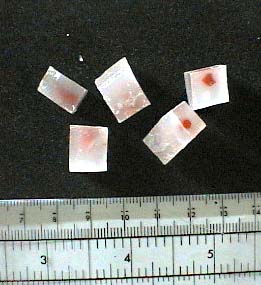 You can see the wax blocks here. I have pre-stained the specimen red so that it is visible
within the wax. Blocks must be small enough to fit into the centre of the hand microtome and long enough to ensure
a fair number of slices can be cut from the block. The smaller divisions on my ruler show centimeters, the larger
ones are inches. You can see the wax blocks here. I have pre-stained the specimen red so that it is visible
within the wax. Blocks must be small enough to fit into the centre of the hand microtome and long enough to ensure
a fair number of slices can be cut from the block. The smaller divisions on my ruler show centimeters, the larger
ones are inches.I have chosen Jasminum nudiflorum (Winter Jasmin) as my specimen for these blocks. A rather nice plant with pretty winter flowers. These are soft plant stems so should be fairly easy to cut! Microtomes It's not my purpose to promote the items in the Mic-UK onview shop but I do have friendships and associations with Maurice Smith - (old MOL), the guy who coordinates Mic-UK and its various associations and work, as well as running the commercial aspects which assists the non-profit aims of the site and enterprise. Since I know you can get resources to follow my projects from these guys and their on-line shop, I will use the same resources in my projects. I am using the Brunel Bench Microtome. There are better made microtomes but they are more expensive, heavy - and therefore expense to ship, and I know how to get the best out of this one with a few simple alterations which you will have no problems doing as well. 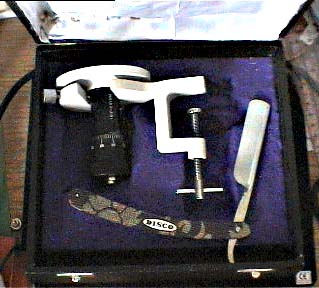 Use whatever hand or bench microtome you like but the Brunel one comes boxed like this (I bought this one), with a sectioning razor too. We won't be using this razor at all, nor in fact - any razor! More on this in a moment. You can't cut thin slices from a section without using a microtome - so try and get hold of one. If you have the time, it is even possible to make one yourself but it's probably cheaper in the long run to buy this one. The bench microtome, when in use, needs to be clamped to a stable solid bench or table. The picture below demonstrates the set-up of a bench microtome. 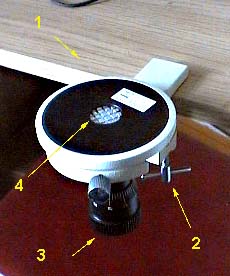 1) Work bench or table. 1) Work bench or table.2) Thumbscrew to clamp microtome to a table. 3) Section thickness adjustment and advancement control. 4) Wax block will be fixed here in the centre chuck, We will be making some small improvements to this microtome (no engineering involved) to make it more useful for getting perfect sections. Hand Cutting tools Most people, including the majority of microscopy enthusiasts, probably think a sectioning razor is the best cutting tool for slicing off sections from a wax block. Let me assure you - it is not! This is a sectioning razor - almost identical to a cut-throat razor:- 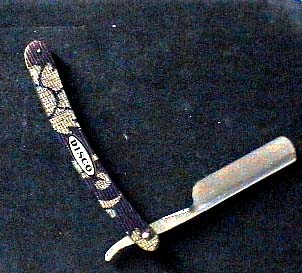 Sectioning Razor Sectioning RazorA sectioning razor has several weaknesses when used for hand cutting wax-embedded sections:- 1) It is too flexible and tends to bow. 2) The cutting edge is not strong. 3) Often made of inferior materials. 4) Extremely dangerous in use. It looks the business but it's basically useless for our purpose. You will not get perfect hand-cut sections with this! A very powerful secret unlocked! Sometimes, you get told something in life that just can't seem to be true - yet is! We are conditioned to think and model artifacts in certain ways, so when we think of trying to cut tiny sections of material for microscopical study, we think of delicate tools and fine utensils as being the ones of first choice. You would not expect to consider a pipe wrench or car jack and similar tools from more physically demanding endeavors to be of much use here in our area of interest, would you? Well hold your breath, suspend your disbelief, because what we are going to use to cut our sections is the blade from a carpenter's plane: it is called a plane iron. Here are two - removed from a plane:- 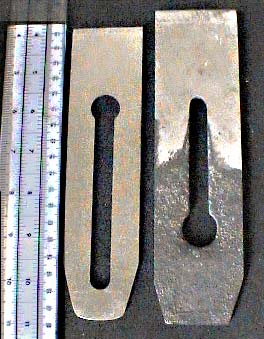 The largest of these is
7 inches long and over 2 inches wide. It is made from solid, good quality steel, and is very heavy. One thing is
certain about these two brutes, they are not going to be flexing at their cutting edge and spoiling our cuts when
sectioning! The largest of these is
7 inches long and over 2 inches wide. It is made from solid, good quality steel, and is very heavy. One thing is
certain about these two brutes, they are not going to be flexing at their cutting edge and spoiling our cuts when
sectioning!You need to obtain a plane iron. It must be good quality steel. These two I purchased from a DIY shop - not a modern store - but a back-street one which carried a lot of old stock. These were made by a company called 'Record' and were recognised as good quality tools... albeit before the advent of cheap and almost useless imported steel tools of a modern era. I paid 3.00 pounds for each. Shop around. Check out the oldest member of your family and his or her tool kit. You are more likely to find a good quality steel plane iron in an old tool kit then in a modern one! Try those hardware stores that look like they aren't making any money and look like time passed them by. They will still have some of these or similar quality ones hidden away somewhere, especially if the guy or gal running the store really cares about good quality tools. (continue...) |
|
About this page | Project Index | Larry's Learner Purchases on-line | This Project Page: 1 - 2 - 3 - 4 | Micscape | Mic-UK | |
|
All material is copyright of Larry Legg, Microscopy-UK and Onview.net Ltd 1998/99/2000. All rights reserved. All non-email communication to Larry may
be made by fax or written (postal mail) to:- |